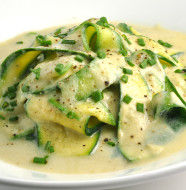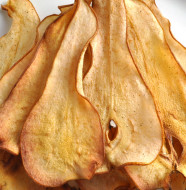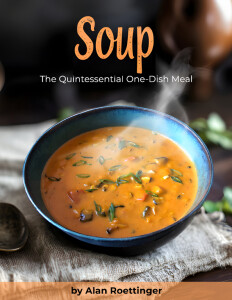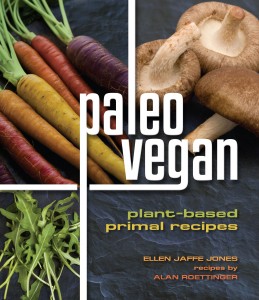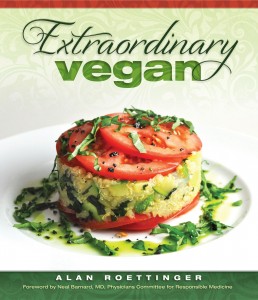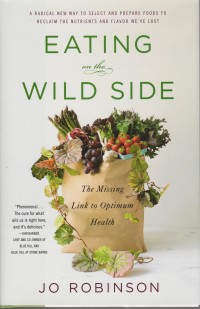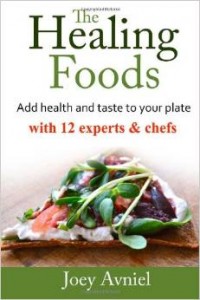
Last year, I was approached to write a chapter for a book on healthy eating called The Healing Foods, by Joey Avniel. I was glad to participate in this project because it seemed right in tune with my own philosophy regarding food and health. If you’re interested, you can read about the book—and follow a link to buy it on Amazon.com—at www.thehealingfoodsbook.com. There are a total of twelve contributing authors, each with a unique perspective on food, health, and the benefits of a plant-based diet, and each offering a few recipes. For those of you who might like to read what I had to say in my chapter, I’ve included it below.
My perspective on food and health, as indeed on life and living, hinges on what I’ve come to understand as the most fundamental, inescapably urgent factor of our existence. I submit that it is the key to understanding life itself, the intention behind everything. I’m very interested in any comments you may have, so please don’t hold back.
.
.
.
.
THE ENJOYMENT FACTOR
In my thirty years as a private chef, I’ve learned a few things about human nature in general, and about our relationship with food in particular. Among the many luxuries wealthy people can afford is the luxury of never having to eat anything that doesn’t taste good to them. Really. They don’t have to. Ever. If they want, they can just send it back and have it made over again, to their liking. This doesn’t necessarily mean that what they like is particularly good for them, or will help them accomplish any health goals they may have. They’re just people, and most people have a few if not a plethora of unhealthy cravings. All it means is that they get to have whatever they want. This applies to food, but also to every other aspect of their living experience that can be bought or influenced with money. Just imagine what a marvelous environment for observing human nature that would be. I was able to observe people at the pinnacle of power, wealth and fame—people who have what everyone else dreams of having. Let me share a little of what I’ve learned with you. I think you’re going to like this.
Understanding What Motivates Us
Millionaires and billionaires, movers and shakers, moguls and movie stars get a lot of perks, but they receive no special discounts or advantages when it comes to the basics of being alive, or being human. At the level of being alive in a human body, we’re all exactly the same. This is a good thing.
We are all, fundamentally, creatures of hunger, of thirst and longing. We’re essentially empty, and in constant need of filling. Our very cells are in a ceaseless process of being made, unmade, and made again, and without the requisite fuels and building blocks, this process would wind down and stop rather quickly. So we must eat and drink, and, foremost—though we take it for granted more than any other aspect of our living experience—breathe. I’m sure this isn’t news to anyone, but there is much more to it than what amounts to the dry drudgery of a construction site. There is an unseen, very interesting force that keeps the whole operation moving.
Embedded in the basic programming of not only humans but every living creature, there is a singular primary directive that drives all the instincts, from survival to reproduction. Everything we do, consciously or unconsciously, is at its root a response to one imperative: seek, find, and feel joy. Most often, we notice this as a response to some form of pain, like hunger, cold, or boredom—and of course that’s part of it, but what we’re looking for is not merely an escape from pain. It’s not enough for us to not be feeling bad; we want more than that. We want to feel good. Miraculously enough, this is almost always possible, and even when it’s not, there is hope that at some not too distant point, it will be. It’s always the goal, and it’s virtually always attainable. This is what it means to be alive.
But we are restless creatures, born to move, and even that isn’t ultimately enough for us. We want continuous improvement. We want each day, indeed each experience, to be better than the last. Why is this? It’s because our inherent wisdom informs us that it’s not only possible, but in fact necessary. Each incremental evolutionary step is a response to this yearning for advancement, in both form and function. If you’re uncomfortable with the word “evolution,” feel free to insert the word “refinement.” Same thing: at one point something wasn’t quite good enough, so it changed for the better. It became necessary, it was possible, and it happened. However we may feel about this, it is indeed afoot, and though we may fight change, it too is our nature. We are a work in progress, creatures in constant flux. There is not a single cell in our bodies that was there seven years ago. They’ve all been switched out with brand new matter. This is what makes growth, healing and even life itself possible.
Maybe you’re thinking that not every change is for the better, and in the short term, you would be right. Disease is a most unfortunate change that affects nearly every single person at some time in the course of their life. As I write this, I’m recovering from passing a very large kidney stone—so large, in fact, that it had to be surgically broken up and removed—and participating in this adventure was by far the least fun thing I’ve ever done. But the change that brought excruciating pain led to a series of other changes, and in just one week I’m already starting to feel good again. Yes, but not every form of illness or dysfunction is curable, you may say, and again you’d be right. And not everyone is born with properly functioning equipment. But, getting back to that primary directive that everyone is born with, the possibility of finding joy is always with us, regardless of our circumstances. I was with my eldest sister when she died of multiple cancers, and although at the end she was unable to speak, the last look I saw in her eye was one of undeniable joy. It is inherently possible for us, right up to that final exhalation.
This brings me to an intriguing and important twist: There is no craving or longing we have which does not have a corresponding substance or experience that fulfills it. We thirst, and water exists. We hunger, and food in many forms exists. We crave company, and we are not alone. We long for fulfillment, and fulfillment is always there to be had. It would be accurate to say that we exist in seamless concert with our environment. It’s one big perfect setup, and everything we need is here. Our task is to live in harmony with our environment, and whether we’re aware of it or not, we’re also very well equipped to do this. Life is perfect, we’re the perfect creatures to appreciate it, and we live in the perfect world for it all to happen.
Learning What Works
So how do we go about living in harmony with our environment? I can’t give anyone specific instructions—there aren’t any. What I can say is that we each have the specific tool for figuring it all out, and that tool is feeling. It’s not a difficult device to operate—it’s automatic, in fact—but it can take a little time and reflection before we realize that we’re not merely adrift amid a meaningless series of random, disjointed experiences; in fact, we’re in possession of a highly effective tool that can help us find our way and make sense of it all. Nonhuman animals seem to use it without the slightest awareness that they’re learning anything at all. Here’s how it works. If we make a mistake, it feels bad. If we get it right, it feels good. It’s really that simple. The only catch is that in order to enjoy the maximum benefit, we need to be paying attention.
There are some potentially misleading nuances that we need to sort out, too. For example, the very first sip of alcohol will usually taste pretty nasty (and that should tell you something). But you see other people enjoying it, so maybe you keep trying. Then you start to like it. One drink, feel pretty good. Two drinks, feel better. Three drinks, you’re on top of the world. Four drinks, and (if you’re still paying attention) feeling good is starting to waver a bit. Five and beyond, you’re beginning to feel a little sick. Next morning, feel absolutely wretched. This is how we learn. It takes some time, but we can finally come to understand what works for us and what just doesn’t. Some people can trust their instincts from an early age, and are able to avoid a great deal of suffering. Others have to live it to learn it. The goal is to be able to enjoy our life, regardless of what cards we were dealt at the beginning of the game, and the key to success is being conscious as we go.
The efficacy of this feel good/feel bad learning method improves dramatically the more we pay attention. When I first began my career as a chef, I couldn’t possibly have cared less about the effect of my food on overall health. I was all about impressing my patrons—surprising their imagination, making their palate dance, and (to a reasonable degree) justifying the cost of hiring me. I was on my way up, and I wanted to make an impression. Also, I loved my food (I always have). If I made something that didn’t pass my own taste-test, I wouldn’t serve it, period. I was in my mid-twenties, and I could eat pretty much anything with impunity. I scoffed at all concerns regarding fat, sugar, cholesterol, and any diet-related disease. I was all about the mouth; whatever happened from the neck down was not my department. It wasn’t until I was in my forties that I began to consider what my food was doing to my body—and the bodies of my clients. Then something happened that changed my whole paradigm. I started paying attention to the way I felt immediately after I ate. At that point it was too much to ask of a dedicated hedonist like me to tune into my body’s reactions at the moment of eating—I was far too busy enjoying the sensations—but it was a start. If I’m paying attention now, I can tell immediately if what I put in my mouth will agree with my body or not. The feel good/feel bad mechanism has become my closest ally.
Conscious Eating
There are three basic ways to approach food and eating:
(1) Eat whatever you enjoy or crave, and ignore the consequences—until they become acute, then seek medical intervention and hope it’s not too late. I think the problems associated with this approach are fairly obvious, although it is the approach most people—rich and poor alike—prefer to take. Fundamentally, it relies heavily on the safety of the food system and the integrity of food suppliers, neither of which, to put it kindly, has been shown to be entirely trustworthy. The one advantage of this approach is that people get to eat what tastes good to them, so at least at the precise moment of eating they are in complete harmony with their primary directive. This has power, to be sure, and some people do quite well right up until the onset of old age. But no one knows if they will be among that fortunate group—especially now, with all the non-food additives, artificial ingredients, and genetically modified organisms present in virtually all processed food. It’s rather like that Russian game, involving a revolver loaded with a single cartridge in one of the six chambers. You could get lucky. Your move.
(2) Eat only what is supposed to be good for you whether you like it or not, and hope for the best. A principal problem with this approach is that the experts who dictate what is supposed to be good for us often disagree, and this becomes even more confusing as new information causes some of them to change their minds. Keeping up with the latest opinions can be an exhausting enterprise, and eating accordingly is generally a joyless exercise. So of course the really bad part is that in order to follow this approach, most often people must override their primary directive, putting enjoyment off until the results of their diet come in—with no guarantee of success. Another disadvantage is that many people equate health and fitness with physical appearance—specifically a thin figure—and they tend to swing from one fad diet to another in the constant pursuit of an arbitrarily ideal weight. This can take a harsh toll on their bodies, and few are the experts who will warn them about it. The real disadvantage is that because it’s in direct conflict with their primary directive, they’re fighting an uphill battle against an implacable force—and there’s no joy. This method is like playing the lottery; someone may get lucky, but the chances of it being you are close to zero.
(3) Find out which foods benefit you—by both research and experience—and find ways to make eating those foods enjoyable for you. This is by far the most reliable approach, for a number of reasons. First and foremost, it is entirely in tune with our primary directive, so it’s easy to be fully committed to it. Secondly, it puts us in control of what we eat and why, so we’re empowered by our choices.
This approach is not a static one, because foods that work in one season or at one point in our lives may not work at other times. It demands participation on our part; we must pay attention for it to work well. It requires an openness to new methods, new information, and—if we really want to enjoy it to the fullest—new foods. The only challenge associated with this approach is that it takes more work than the first two, but if we commit to it, it’s exceedingly enjoyable work, with a much higher rate of success. We get to revel in what we eat, it makes us healthy to eat it, and we’re in control the whole way—what’s not to love?
Now that I’ve made a case for what could be called conscious eating, the next step is implementing it. First, know that only you will be able to discover which foods work for you. There is a lot of good information out there for you to access, but each person is unique, and the feel good/feel bad method is the only truly reliable one we have in our quest for the ideal diet. Second, remember that adjustments will always be a part of this approach, so you’ll need to stay open and be ready for change. Third, in order to ensure success, the crucial component is learning to cook and eating at home. Please don’t be alarmed; I’m an avid proponent of the primary directive and I won’t let you down.
It’s Not Rocket Science
Making something good to eat is arguably the most ancient activity of civilized humans. If you wander around an archaeological site, you may or may not find any figurines or arrowheads, but you will almost certainly find an abundance of potsherds, the remains of rudimentary cooking utensils. I grew up in Mexico, and I visited many such sites as a child—Toltec, Mixtec, Zapotec, Cholulan, Olmec, Mayan—and despite differences in art and architecture, they were all awash in potsherds. Nearby museums at some of the relatively recent sites displayed more complete pottery, along with grinding stones, obsidian knives, and other kitchen equipment. If they could make tasty food with those crude implements, it should be a snap for us with our modern equipment, don’t you think? Honestly, it’s not that hard.
I consider the ability to make good food an essential life skill, akin to building a fire, or a makeshift shelter, tying a tourniquet or a splint, and many other basic survival skills. Everyone should at least know how, whether they do it every day or not. Without this skill, we are at a distinct disadvantage, like someone who doesn’t know how to change a tire, read a map, or write a check. Being able to make extraordinary food (which really isn’t much harder) is a huge advantage, like being able to speak a second language, or play a musical instrument. It enriches your life experience beyond words. They’ll love you everywhere you go, trust me.
I’m not able to teach you how to cook in this short chapter—believe me, I want to, and I would if I could—but I will introduce you to some of the enjoyable aspects of cooking, as well as the attending benefits. As with any art, there is a learning curve, but there is also a fascinating phenomenon associated with acquiring a new skill. Once you learn even some basic moves, you will naturally want to practice them—because you can! The more you practice, the more you begin to get good at it. And then you really want to do it, because it feels great to be good at something. Finally you master it, and doing it is second nature; it becomes virtually effortless. And cooking is one skill that benefits you and everyone around you in profound, practical ways.
The process of working with fresh produce—washing, peeling, cutting, slicing, dicing, grating, shredding, chopping, crushing, or pureeing—is a relaxing, meditative experience. Even without a teacher, it’s easy to invent interesting, eye-appealing shapes and develop clever time-saving moves. It does help to read cookbooks, which will put you many steps ahead of the game, but actually doing it is the best teacher. Discovering how the alchemy of salt, acids, fire, ferments, and even just plain water works to transform ordinary materials into an extraordinary eating experience is a thrill that will be yours again and again. The sights, sounds, and intoxicating aromas of cooking are delightful, and only the cook will enjoy them all, because by the time a dish is served, it will have undergone several if not many changes, and the guest only gets to experience the final form. That last stage, where you arrange your creation artfully on a plate, can fill you with a profound sense of accomplishment. So, so enjoyable!
Speaking of the guest—and I regard everyone who enjoys my food as my guest, whether it’s a client, a friend, my wife or anyone else—there is something truly magical about the sounds the guest will make, or better yet, the way an entire dining room spontaneously falls silent when guests are eating extraordinary food. Those sounds—or that electric absence of speech—will make even an entire day standing in the kitchen much more than worthwhile. From that moment on, you will have a unique kinship with those people for the rest of your life. A wise man once said to me, “If you want to love people, serve them.” I can’t possibly tell you how right he was, but what he didn’t tell me was how they would also love me. Among the many things you do in your life, be a cook. It’s one thing you’ll never regret.
The Benefits of Joy
I hope I’ve incentivized the art of cooking enough to at the very least make you curious. Now let’s get down to why enjoyment is so important in food and eating. I’ve described how preparing the food can be marvelously enjoyable, which should explain why so many have done this throughout time, and it’s no mystery that we all thoroughly enjoy eating delicious food, but there is also a practical benefit to the enjoyment of food itself. Of course, it’s a response to that all-powerful primary directive, but it also plays a part in the absorption of nutrients.
Not long ago, I read about a study conducted in the 1970s, in which a spicy Thai meal was served to a group of Thai ladies and a group of Swedish ladies. Needless to say, the Thai ladies enjoyed the food far more than the Swedish ladies did. What was interesting, however, was that the Thai ladies absorbed nearly 50% more iron from the exact same food as did the Swedish ladies. At another time, the Thai ladies were served the same spicy meal they had enjoyed before, only this time processed into a disgusting homogenous slop, and they absorbed 70% less iron from it than they had the first time. Identical ingredients and quantities were used, eaten by the same subjects, with the single difference being that one meal was enjoyable and the other was not. Ignore the primary directive at your peril, I say.
If you think about this for just a few minutes, it all makes perfect sense. When the aroma of a delicious meal wafts under your nose, digestive juices begin to flow impulsively. As the gorgeous feast is set before your eyes, your mouth waters, and your stomach actually rumbles. By the time you take your first bite, your entire digestive system is reaching for it, eager to begin the process of breaking it down so your body can be nourished. Joy—enjoyment—is the leader, and everything else follows. It’s brilliant.
From the other perspective, which is simple raw hunger, we’re sometimes drawn to food by nothing more than an urgent, unstoppable need. If you’re hungry enough, you don’t really care how good the food is; you just need to eat. It’s a fact of life, going back to my core observation: we are fundamentally creatures of hunger. It’s what we do; we hunger, every single sentient one of us on planet Earth, and there is no escaping it. When we’re truly starving for food, we couldn’t possibly care less about nutrients, health or—especially—haute cuisine, which is why they say you should never shop hungry. You’ll end up grabbing and eating some awful junk you’d never allow past your lips under any other circumstances. You go primal. You completely forget about health or the need to enjoy your food. It’s not even the vaguest fleeting concern. But guess what? The moment you begin to eat, even if it is indeed some awful junk, it somehow becomes the most delicious awful junk in the universe! Why? Because, my friends, we’re hardwired to enjoy, and enjoying is one thing we do extremely well. Even water, which is supposed to have no taste at all, becomes a ravishing revelation when we’re desperately thirsty. It’s like diamonds of pleasure going down, like sublime music that soothes and excites at the same time. There is nothing more delicious than plain water when you’re genuinely in dire need of it. Bottom line: there is nothing so orgasmically sweet as that precise moment and place where a burning thirst is being quenched, where an extreme hunger is being satisfied, where the deepest longing is in the very process of being fulfilled. Being present in that time and place is why we’re alive, and it makes incontrovertible sense when (and only when) we’re there. Joy to the world!
Supporting a Human’s Right to Choose
We are complicated beings, and there are also ethics to be considered. As we pay attention more consistently, sooner or later the issue of what is ethically defensible for us to take and eat is bound to arise. It’s not for me to judge anyone for their food choices (truth be told, I sometimes do, but it really isn’t my place). However, I submit that in the interest of having uninterrupted joy—which is indeed desirable—it would behoove each of us to examine our feelings relating to eating foods that originated in the suffering and death of other creatures.
Far be it from me to tell anyone what they should or should not eat—or do, frankly—God knows I don’t want anyone telling me what to eat (or do). But it’s only logical that this particular topic should come up in the context of enjoyment, because it’s one that has a real potential to dampen the pleasure of eating. I was travelling with my family in Mexico many years ago, and we happened to be on a ferry boat, parked next to a truck loaded with stack upon stack of cages full of terrified pigs. As the boat would lurch this way and that, the pigs would shriek and scream horrifically. It was blood-curdling, and it haunted us for a long time after we reached the shore and drove away. Several days later, we were at a restaurant on Isla Mujeres, off the coast of Yucatán. My mother ordered cochinita pibil, a regional pork dish (don’t ask me why). As it was set steaming and sizzling before her, my father (ever the joker) let out an uncanny imitation of the shrieking pigs. She never managed to take a single bite. She didn’t say a single word to him for the rest of the day either, which just goes to illustrate a key point: being confronted with the realities surrounding the source of animal-based food is a major turnoff.
What we eat is among the most personal choices we make, and I think each person should be given the space to make this choice, always, with no pressure and no judgment. Vegans will often be quick to interject that it’s not strictly a personal choice when it involves an animal who wasn’t included in the choice-making, and I have to say I completely agree. I mean, if a cannibal were to characterize the eating of human flesh as a personal choice, we’d all have plenty to say about that, wouldn’t we?
But the fact is, humans have been eating animals for millennia, and the decision to stop is a momentous one that each person must be allowed to make out of his or her own conviction. And I’ll be brutally honest, if I were beside myself with hunger (I mean seriously starving), and the only food within twenty miles (on foot) was a plate of buffalo wings, I have not the slightest doubt that I would wolf it down, chase it with a beer, and go back to my vegan diet later. Survival comes before conviction. I only bring up this uncomfortable subject because I believe it’s in the best interest of a guilt-free, fully enjoyable life to go about our choices in broad daylight and fully understanding the implications. That way there’s no gray area, no unacknowledged uncertainty, and no regret to come later. For anyone who may be unfamiliar with the realities surrounding animal products, or the plight of farm animals, I highly recommend reading Eating Animals by Jonathan Safran Foer. No grisly videos to watch, no moralizing or finger wagging, just a frank discussion what goes on during the production of each of the meat, egg, and dairy products we’ve all assumed were wholesome and natural. Two words: no joy. I think that about covers it.
Now, to any readers who may be contemplating the switch, or who may have recently decided to go for it, I have some heartfelt advice. Make sure that whatever you eat is delicious and satisfying to you. This may or may not seem possible for a person who has eaten an animal-centric diet, and I’m not suggesting that any of the meat or dairy substitutes will do the trick (they never fooled me, not even a little bit). What I’m saying is that your new food choices must be as deeply gratifying to you as the animal-based food you’re leaving behind, because you deserve this. You were born to enjoy, and enjoy you must, because otherwise you will not be able to stick with it. And trust me, what I’m proposing is entirely a doable thing.
I was working for a client in Malibu, California years ago who not only loved eating meat, but also enjoyed going out in the woods and shooting animals to bring back and eat. He had a high stress job, and he had the high blood pressure to go with it. His face was beet red most of the time. He also had vertiginously high cholesterol (I think it was up in the 400s somewhere). Even the statins couldn’t keep up. One day he came home from a doctor’s appointment looking like a whipped dog. He reported to his wife that his doctor had told him he must immediately stop eating all animal products or he would die. “Oh, honey!” she said, like this was an insurmountable tragedy. I asked him if he was committed to following the doctor’s orders. Still somewhat in shock, he assured me that he was indeed committed—and highly motivated. He really didn’t want to die. I assured him that I could make him food with no animal products and he would not feel deprived. He was incredulous, but hopeful. This was at least fifteen years before I went vegan, but I knew food and I knew it was possible, because he loved to eat. For the next eight months, I made him something different every day, and he never wondered wistfully where the beef was. Or the cheese, or the chicken, or the pork, turkey, quail, duck, pheasant, squab, boar, elk, venison, or any of his other favorites. He lost a lot of weight and his cholesterol, predictably, plummeted. He was happy (and so was I—job security, you understand). He was also amazed, and very grateful. So when I say it’s possible, I know what I’m talking about. I mean it’s positively, practically, possible. It does take a little work, but let’s face it: everything of value takes more effort than things of little or no value.
Initiating a Paradigm Shift
To my vegan friends reading this, I know you’re keen to see more and more people transition to a plant based diet. I am too. So, in the interest of seeing that happen, I’d like to offer a heartfelt suggestion. Let’s make sure that whatever we offer people as an alternative to animal-based food is beyond gratifying. It’s not about imitating meat convincingly; that really isn’t possible with real food, and it needn’t be the point. I see it more as blazing a whole new trail, drawing in part on ethnic cuisines that have been mostly vegetarian for centuries (they know how to do it right). Extraordinary food in the west has been dominated by menus with an animal featured in every item for long enough. Time to create a new model!
The standard American diet is terrifyingly devoid of nutrient-dense food, and replete with process-damaged fats and refined carbohydrates. I propose a radical departure from this thrice-daily assault on nature. Rather than “veganizing” the wretched diet we’re accustomed to, I advocate a clean break and a brand new start. If you look at the ancient cuisines like Indian, Thai, and Chinese (to name just a few of the many examples), there is a direct link between food and medicine. Their fundamental flavoring agents—ginger, garlic, chiles, turmeric, cinnamon, and many other spices and herbs—are used every bit as much for their healing and health-supporting qualities as they are for flavor. The old cuisines are also wonderfully diverse in their range of ingredients, including many kinds of whole grains, beans, lentils, vegetables and fruits, all naturally rich in fiber and phytonutrients. The world of ancient ethnic cuisines is vast and rich in potential for both health and pleasure.
Let’s raise the standard of vegan food to world stage quality. I think most of the old hippies are already on board, so it’s time to welcome ardent foodies and cosmopolitan people who keenly enjoy eating well. I’m quite hopeful, and I don’t think it will be very difficult. Great food, I must tell you, is just a few steps beyond decent food. Designing it is a short departure from the monochrome and the monotone realm of dull food. It’s often nothing more than creating envelopes of surprising pleasures that open slowly, where layers of flavor cascade out thrillingly. Does that sound complicated? It isn’t. It’s a simple matter of building on your taste memory and pursuing enjoyment. It’s fun!
As a cook, I know that all the subtlety and excitement in food comes from plants, not animal products. A Spanish chef I admire by the name of José Andrés once made an incredibly astute observation. He described eating a piece of meat as a fairly boring affair, by saying that for five seconds, you get a burst of flavorful juices, and then for twenty-five seconds all you’re really doing is chewing and chewing so you can swallow the bloody thing. In contrast, he said you never have that problem with an asparagus spear, or a strawberry. Every single bite of plant food is bursting with vibrant flavor. Mind you, that came from a meat-eater, not a vegan. We can do this! We can lead the world to superior eating on all levels—diverse, healthful, creative, gratifying, sustainable, ethically defensible, and above all, joyful.
I hope I’ve made a case for the vital importance of enjoyment in everyday food, because enjoyment is indeed the one indispensable thing in life. If you’ve ever heard of a person—or animal—dying “of a broken heart,” it occurred because the connection that person had with joy had been lost, and the will to live had naturally gone with it. We mustn’t let that happen in our life. What we eat literally becomes our flesh, blood, and bones, and what is enjoyed deeply becomes a luminous part of our being, blurring the line between the physical and ethereal. We are, after all, made out of pure energy, with particles joining and leaving us continuously throughout our stunningly miraculous lives. Of all the creatures on Earth, only we get to consciously choose the nature and quality of the foods that will pass through and briefly be a part of us. If we choose wisely, we can make this transaction a beneficial one on every level. Above all, we can make the choices that will lead to profound, heartfelt gratitude. I’m fairly certain everyone will agree that genuine gratitude is the uncontested king of all joys.
Eat smart. Live joyfully.


